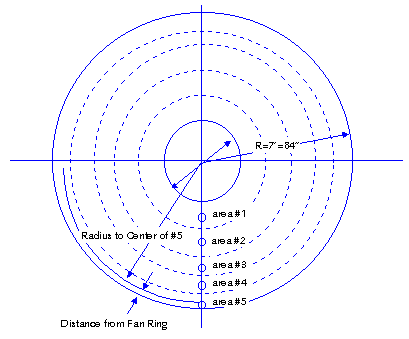|
4) Comparisons of Accuracy: Pitot vs Anemometer
The following was reported
in the CTI paper TP-84-15 by Wheeler, Wilber and Starnes,
as a result of testing using anemometer vs pitot tube.
Compare average difference in ACFM (two runs each).
- ● Average ACFM (% difference).........
0.96%
- ● Pitot Tube Repeatability
was ......... +/- 0.19%
- ● Anemometer Repeatability
was ..... +/- 0.75%
There is no authoritative
number you can place on accuracy of a particular instrument.
Effect of variations on wind changes during the test,
accuracy of calibration, proficiency of the tester,
and choice of measurement location affect the overall
"absolute" accuracy of the of the flow measurement.
For example, the following results using the same operators,
measuring the same cell, using the same instrument with
same fan setting. Again, from data reported in TP-84-15:
| |
Pitot
Tube (ACFM) |
Anemometer
(ACFM) |
| 1,488,900 |
1,466,500 |
| 1,494,500 |
1,488,600 |
| 1,544,800 |
1,540,500 |
| 1,494,300 |
1,480,100 |
| 1,547,400 |
|
| Average |
1,514,300 |
1,493,925 |
| Percent
difference between readings |
3.78% |
4.80%(anem.) |
Percent difference between
average readings of pitot vs anemometer was 1.35%. Keep
in mind these are with will calibrated instruments in
the hands of trained technicians.
5) Preparing for Air Flow
Test
(1) Decide where you're going
to test
(2) Measure the inside diameter
of the ring or stack at the measurement plane and the
outside diameter of the seal disc.
(3) Calculate the distance
to the center of the equal area bands using the net
free area calculated from step two.
(4) Prepare your equipment
- ● Mark off the distances
to the measurement points with tape around the pole
of your instrument. Lay out from the center or the
anemometer to the edge of the fan ring for each equal
area band. Calculation method is shown below.
- ● If you are measuring temperature,
attach a thermocouple to the pole with its sensing
bulb near the end that airflow and temperature are
both measured.
6) Calculate Anemometer/Pitot
Locations
A typical airflow test requires
measuring velocity at the center of 5 equal area bands
in four quadrants, plus one reading directly over the
center of the fan. This is 21 readings total and is
considered the minimum acceptable number. For fans over
20 ft diameter, 10 equal area bands should be considered.

(1) Let DF equal the inside
diameter of the fan ring. Let DSD equal the Seal Disc
or Hub diameter.
(2) Calculate the following:
- ● Gross Area (AG)
= 0.7854(DF)2
- ● Net Free Area (NFA) =
0.7854(DF2 - DSD2)
- ● Area/Band (A/B) = NFA/(2
x Number of Bands)
(3) Area within center of
Band 5 = (AG - A/B)ft2 = A5
R5 = (A5 / p)1/2ft.
Radius to center of band 5
(4) Area within center of
Band 4 = (A5 - 2 x A/B) = A4
R4 = (A4 / p)1/2ft.
Radius to center of band 4
(5) Area within center of
Band 3 = (A4 - 2 x A/B) = A3
R3 = (A3 / p)1/2ft.
Radius to center of band 3
(6) Area within center of
Band 2 = (A3 - 2 x A/B) = A2
R2 = (A2 / p)1/2ft.
Radius to center of band 2
(7) Area within center of
Band 1 = (A2 - 2 x A/B) = A1
R1 = (A1 / p)1/2ft.
Radius to center of band 1
(8) Calculate distances from
fan ring to anemometer measurement points.
d5 = D/2 - R5
d4 = D/2 - R4
d3 = D/2 - R3
d2 = D/2 - R2
d1 = D/2 - R1
Note that one reading is
taken over the center of the fan. This will indicate
a negative air flow (down). It must be advantage in
with one quadrant's velocities.
(9) Sample Problem: Calculate
anemometer positions to measure flow a 14 ft. fan in
a 14'2" fan ring with a 45" seal disc.
DF = 14'2" = 14.166
ft.
DSD = 45" = 3.75 ft.
AG = 157.63 ft2
NFA = 146.59 ft2
Area per Band (A/B) = 14.66 ft2
- ● Area to center of Band
5 = AG - A/B = A5 = 142.97 ft2
Radius to center of Band 5 = (142.97 / p)1/2=
6.75 ft
- ● Area to center of Band
4 = A5 - 2 x A/B = A4 = 113.65
ft2
Radius to center of Band 4 = (113.65 / p)1/2
= 6.01 ft
- ● Area to center of Band
3 = A4 - 29.32 = A3 Radius to
center of Band 3 = (84.33 / p)1/2=
5.18 ft
- ● Likewise:
A2 = 55.01 ft2
R2 = 4.18 ft
A1 = 25.69 ft2
R1 = 2.86 ft
Cheek: A1 - A/B should equal ASD
25.69 - 14.66 = 11.03 ft2
ASD = 11.04 ft2 (Checking Okay)
(10) Calculate anemometer
positions measured from fan ring:
| Band |
Center
Point Radius (ft) |
Distance
From Fan Ring (ft) |
| 5 |
6.75 |
0.33 |
| 4 |
6.01 |
1.07 |
| 3 |
5.18 |
1.90 |
| 2 |
4.18 |
2.90 |
| 1 |
2.86 |
4.22 |
|


